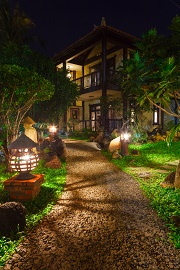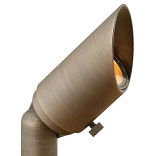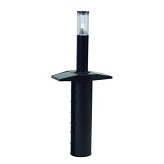 Between 2010 and 2013 the Las Vegas Sands Corp., owner of The Venetian and The Palazzo hotels, saved close to $2.5 million annually by changing their light bulbs to LED bulbs. Such is the power of green lighting. If you are a hotelier looking for a way to be both energy and economically efficient, LED is clearly the way to go.
Between 2010 and 2013 the Las Vegas Sands Corp., owner of The Venetian and The Palazzo hotels, saved close to $2.5 million annually by changing their light bulbs to LED bulbs. Such is the power of green lighting. If you are a hotelier looking for a way to be both energy and economically efficient, LED is clearly the way to go.
However, in your quest for energy efficiency and environmental sustainability, don’t overlook the exterior of your property. Installing LED landscape lighting can substantially increase curb appeal, make your guests’ stay more pleasant, boost security, improve safety, reduce your electricity bill, and significantly decrease the strain your property places on the environment.
Why use LED bulbs over their incandescent, compact florescent or halogen counterparts?
 • Lifetime: LEDs last 50 times longer than a typical incandescent, 20 to 25 times longer than a typical halogen, and eight to 10 times longer than a typical CFL.
• Lifetime: LEDs last 50 times longer than a typical incandescent, 20 to 25 times longer than a typical halogen, and eight to 10 times longer than a typical CFL.
• Electricity use: LEDs use 90 percent less electricity than incandescent bulbs and 50 percent less than CFLs. They also do not give off heat, helping reduce cooling bills and the fading of furniture and other materials that light can impact.
This combination of longer lifetime and lower electricity use results in reduced maintenance costs and power bills, both of which are beneficial for the planet. Additionally, LEDs don’t contain hazardous substances (unlike CFLs), making them easier to dispose of safely
Even Used Often, LEDs Last Long Time
Actual lifetimes for LED bulbs vary depending on use. According to the EPA, an Energy Star rated LED bulb will last over 20 years with typical use. Obviously a hotel environment is not “typical,” but an LED rated for up to 50,000 hours will last more than 11 years if used 12 hours a day.
With LED, quality counts. High-quality outdoor LED lights will last for up to 30 years and are about 80 percent more efficient than other forms of outdoor lighting. As LED lighting comes in a huge variety of shapes and sizes, it is infinitely adaptable to all hotel situations (but it is an especially good fit for landscape lighting, as the smaller bulbs allow for many lighting designs that weren’t possible before LED lights became common).
There are two overall categories for outdoor LED lights: solar-powered or 12-volt powered. Solar LED landscape lights are very simple to install, require no wiring and use no electricity, making them the greenest option. However, solar is far less reliable than electricity and should be used sparingly in a commercial environment, unless you have a very reliable climate.
In contrast, 12-volt LED lights are very reliable, but more difficult to install, because they require laying electrical lines to each light. However, because they use less power than traditional landscape lighting, they generally require small, 14-gauge wiring, which is more easily hidden.
Here are some of the main ways to consider incorporating LED lighting into your hotel’s landscape:
Create an Appealing Ambience
 • Well and Spot Lights: Install these around shrubs and trees to highlight the landscape at night, adding depth and atmosphere.
• Well and Spot Lights: Install these around shrubs and trees to highlight the landscape at night, adding depth and atmosphere.
• Post Lighting: Placed around large features, such as swimming pools or patios, post lighting will cast a romantic glow, or add style along a driveway.
• Wall and Ceiling Lights: Used to highlight the exterior of buildings, wall and ceiling lighting can bring out architectural features, illuminate doors and balconies and create a high-end, appealing ambience.
Get Serious About Safety
• Floodlights: Provide safety and security with LED floodlights, a good fit for lighting stairways, garages or entryways. They discourage intruders and light the way for guests. Position them at least 9 feet from the ground so they cast a wide shaft of light and are not easily accessible. Consider adding motion sensors and timers to increase effectiveness.
Do Both
 • Path Lights: Install path lights along walkways to ensure a safe walk for guests. This is a good place to consider solar powered lights, which can be easily pushed into the ground to provide soft, guiding light. Solar light is generally not as bright as electric path light, as the brightness depends on the amount of sun each light’s receptor is exposed to, the quality of the photovoltaic cells and the size of the LED bulb.
• Path Lights: Install path lights along walkways to ensure a safe walk for guests. This is a good place to consider solar powered lights, which can be easily pushed into the ground to provide soft, guiding light. Solar light is generally not as bright as electric path light, as the brightness depends on the amount of sun each light’s receptor is exposed to, the quality of the photovoltaic cells and the size of the LED bulb.
• Walkway Lights: Usually mounted on stakes or posts, walkway lights come in a variety of styles including hat, mushroom and pagoda. Stagger lights on either side of the walkway to avoid an “airport runway” effect.
• Deck Lighting: An important safety feature, deck lighting can illuminate stairs, benches and railings and flush-mounted lights can be installed in the decking and walked on without damage.
LED lighting has many benefits and, currently, only one major drawback: price. However, as with many eco-friendly solutions, the long-term investment will cancel out the high up-front cost. Plus it’s an investment that will pay off in both dollars and a cleaner conscience.
Which LED lights are best for your property?
Jennifer Tuohy writes about green lighting, including LEDs, for Home Depot. Jennifer provides advice on both energy consumption and money-saving benefits of LEDs, including landscape lights. You can find a large selection of landscape lighting options including LED choices, on Home Depot’s website.





